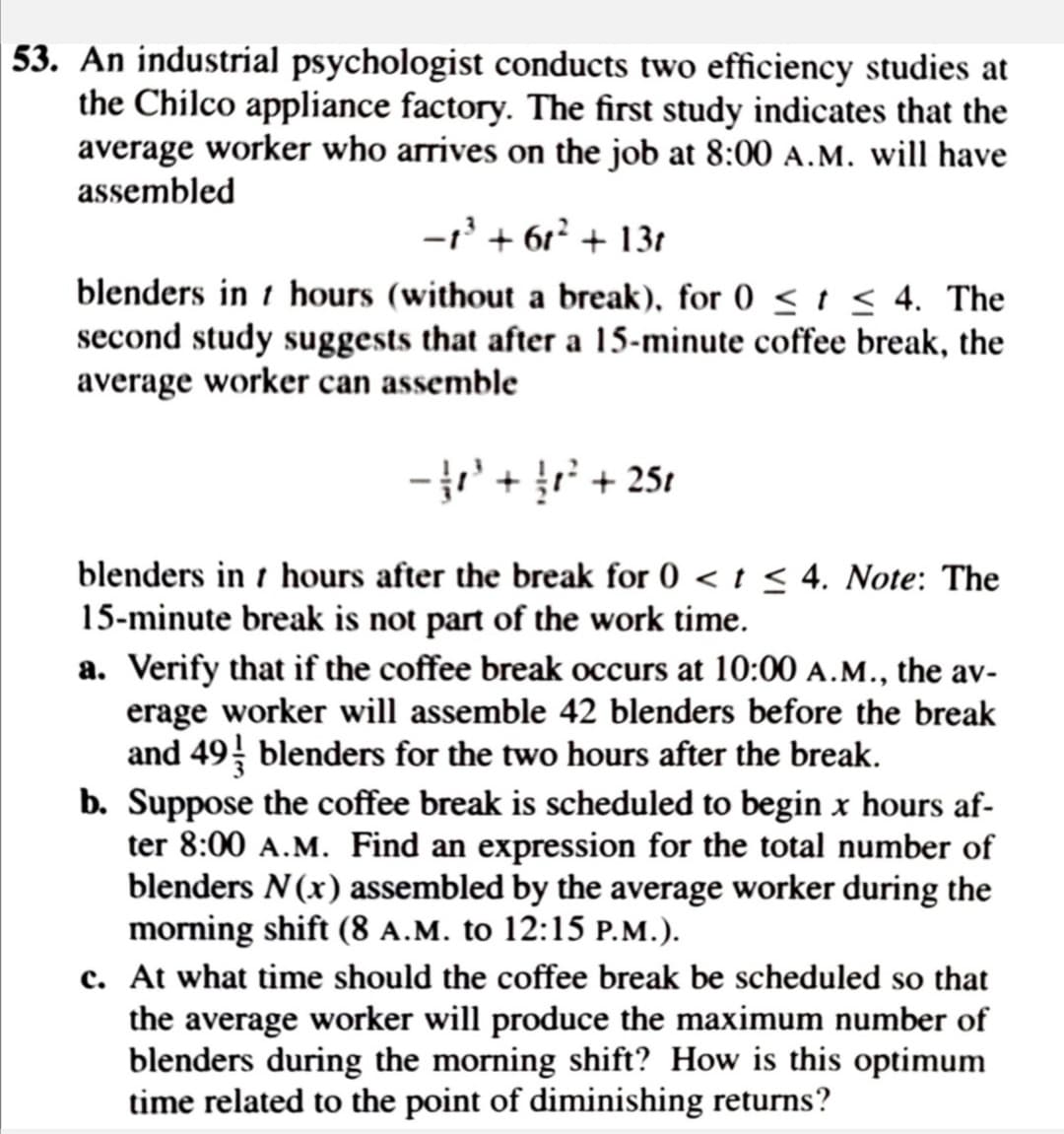An industrial psychologist conducts two efficiency studies at the Chilco appliance factory. The first study indicates that the average worker who arrives on the job at 8:00 A.M. will have assembled -' + 61² + 13t blenders in 1 hours (without a break), for 0 < t < 4. The second study suggests that after a 15-minute coffee break, the average worker can assemble -/ +/ + 251 blenders in 1 hours after the break for 0 < t < 4. Note: The 15-minute break is not part of the work time. a. Verify that if the coffee break occurs at 10:00 A.M., the av- erage worker will assemble 42 blenders before the break and 49 blenders for the two hours after the break. b. Suppose the coffee break is scheduled to begin x hours af- ter 8:00 A.M. Find an expression for the total number of blenders N(x) assembled by the average worker during the morning shift (8 A.M. to 12:15 P.M.). c. At what time should the coffee break be scheduled so that the average worker will produce the maximum number of blenders during the morning shift? How is this optimum time related to the point of diminishing returns?
An industrial psychologist conducts two efficiency studies at the Chilco appliance factory. The first study indicates that the average worker who arrives on the job at 8:00 A.M. will have assembled -' + 61² + 13t blenders in 1 hours (without a break), for 0 < t < 4. The second study suggests that after a 15-minute coffee break, the average worker can assemble -/ +/ + 251 blenders in 1 hours after the break for 0 < t < 4. Note: The 15-minute break is not part of the work time. a. Verify that if the coffee break occurs at 10:00 A.M., the av- erage worker will assemble 42 blenders before the break and 49 blenders for the two hours after the break. b. Suppose the coffee break is scheduled to begin x hours af- ter 8:00 A.M. Find an expression for the total number of blenders N(x) assembled by the average worker during the morning shift (8 A.M. to 12:15 P.M.). c. At what time should the coffee break be scheduled so that the average worker will produce the maximum number of blenders during the morning shift? How is this optimum time related to the point of diminishing returns?
Linear Algebra: A Modern Introduction
4th Edition
ISBN:9781285463247
Author:David Poole
Publisher:David Poole
Chapter2: Systems Of Linear Equations
Section2.4: Applications
Problem 24EQ: Suppose the coal and steel industries form a closed economy. Every $1 produced by the coal industry...
Related questions
Question

Transcribed Image Text:53. An industrial psychologist conducts two efficiency studies at
the Chilco appliance factory. The first study indicates that the
average worker who arrives on the job at 8:00 A.M. will have
assembled
-' + 6r² + 13t
blenders in t hours (without a break), for 0 < t < 4. The
second study suggests that after a 15-minute coffee break, the
average worker can assemble
- + + 251
blenders in t hours after the break for 0 < t < 4. Note: The
15-minute break is not part of the work time.
a. Verify that if the coffee break occurs at 10:00 A.M., the av-
erage worker will assemble 42 blenders before the break
and 49 blenders for the two hours after the break.
b. Suppose the coffee break is scheduled to begin x hours af-
ter 8:00 A.M. Find an expression for the total number of
blenders N(x) assembled by the average worker during the
morning shift (8 A.M. to 12:15 P.M.).
c. At what time should the coffee break be scheduled so that
the average worker will produce the maximum number of
blenders during the morning shift? How is this optimum
time related to the point of diminishing returns?
Expert Solution
This question has been solved!
Explore an expertly crafted, step-by-step solution for a thorough understanding of key concepts.
Step by step
Solved in 3 steps with 2 images

Recommended textbooks for you

Linear Algebra: A Modern Introduction
Algebra
ISBN:
9781285463247
Author:
David Poole
Publisher:
Cengage Learning

Algebra & Trigonometry with Analytic Geometry
Algebra
ISBN:
9781133382119
Author:
Swokowski
Publisher:
Cengage

Linear Algebra: A Modern Introduction
Algebra
ISBN:
9781285463247
Author:
David Poole
Publisher:
Cengage Learning

Algebra & Trigonometry with Analytic Geometry
Algebra
ISBN:
9781133382119
Author:
Swokowski
Publisher:
Cengage